Up, Up, and Away! With
Airline Collectibles
by Bob Brooke
 "They have done it! Damned if they ain’t
flew! said a witness to the first human flight as he dashed into the
Post Office at Kitty Hawk, North Carolina, on the morning of December
17, 1903. On that fateful day, man broke his bond with the Earth. He
flew and a whole new category of collectibles was born. "They have done it! Damned if they ain’t
flew! said a witness to the first human flight as he dashed into the
Post Office at Kitty Hawk, North Carolina, on the morning of December
17, 1903. On that fateful day, man broke his bond with the Earth. He
flew and a whole new category of collectibles was born.
Fifteen years after Orville Wright soared for
59 seconds over the sands of Kitty Hawk, the U.S. Postal Service
received a grant of $100,000 to start an air mail service within the
United States. The US Army flew the first flight from Washington D.C.
with 140 lbs of mail, destined for New York. Unfortunately the pilot
departed the field in the wrong direction, and the first ever 'airmail'
was finally delivered by train. The U.S. Postal Service finally got its
act together and on November 15, 1926 accepted bids for the main
trans-continental routes.
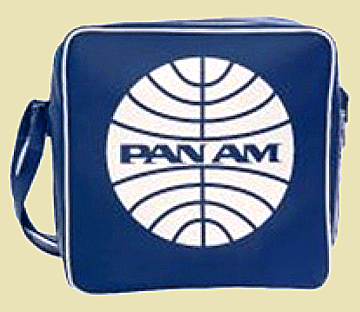 Western Air Express became the first scheduled
and sustained airline in the USA in 1926 when it's mail services became
so profitable that it flew scheduled passenger routes too. Through a
series of mergers and buyouts, four domestic airlines–TWA, United Air
Lines, Eastern Airlines and American Airlines– emerged. Western Air
Express would later be part of TWA. Pan American Airways had grown to
become America's largest international airline opening up routes across
the Pacific and dominating Latin America. Western Air Express became the first scheduled
and sustained airline in the USA in 1926 when it's mail services became
so profitable that it flew scheduled passenger routes too. Through a
series of mergers and buyouts, four domestic airlines–TWA, United Air
Lines, Eastern Airlines and American Airlines– emerged. Western Air
Express would later be part of TWA. Pan American Airways had grown to
become America's largest international airline opening up routes across
the Pacific and dominating Latin America.
By 1930 passenger transport had become an
industry and the major airlines competed for passengers in the New York,
Chicago and Los Angeles. Carrying passengers required lots of equipment
from dishes to playing cards to inflight magazines, even barf bags–all
of which is collectible. And that doesn’t include all the ancillary
items needed to operate a passenger plane such as timetables, crew
wings, uniforms, safety cards, silverplate, flatware, salt and pepper
shakers, trays, liquor miniatures, plastic ware, swizzle sticks, seat
occupied cards, overnight kits, flight bags, soap, hats and hat badges,
patches, buttons, service pins, ticket jackets, annual reports, posters,
and brochures.
Thus it comes as no surprise that many of the
items issued by and for the airline industry have become true
collectibles. Most items associated with commercial aviation are those
designed for a specific purpose at a particular point in time, after
which they’re replaced by later versions, with the older item
presumably discarded.
Airline China
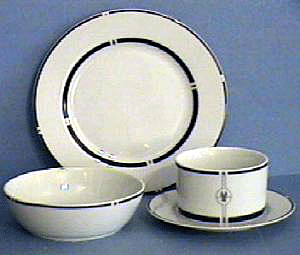 One of the most highly sought after
items is airline china. Some airlines first began serving meals onboard
aircraft about 1930. The earliest marked china dates from the mid-1930's
when airlines had only a couple dozen planes each holding a few dozen
passengers. One of the most highly sought after
items is airline china. Some airlines first began serving meals onboard
aircraft about 1930. The earliest marked china dates from the mid-1930's
when airlines had only a couple dozen planes each holding a few dozen
passengers.
American and Pan Am had some of the earliest
examples of nicely marked china. Most of the early china was very
lightweight so as to not overload the planes.
During the postwar era, most of the larger
airlines used china to serve meals while smaller carriers like Delta and
Continental used plastic. It wasn’t until the early jet era that fine
airline china came into widespread use. Each carrier competed with the
others for speed and service. This included what types of steaks or
lobsters passengers could expect to be served.
In the U.S., the coming of the jet era also
ushered in the common practice of segregating the passengers between
First Class and Economy. In some cases passengers flying Economy didn’t
eat from china, but plastic dishes, or sometimes paper ones. The 1990s
marked a drastic cutback in meal service among all domestic airlines.
Today, domestic carriers still use china in their First Class cabins
while others serve no meals at all on some flights. Those who also fly
internationally use different china on those flights. China used by
foreign airlines is often made by the best manufacturers--Wedgewood,
Spode, Royal Doulton, and Noritake.
Playing Cards
Another popular airline collectible is
playing cards. Long before movies and video games, playing cards were
the only forms of in-flight entertainment provided by the airlines.
Playing cards also served as a low-cost advertisement for the airlines
as passengers usually took the cards home as souvenirs of their flight
experience.
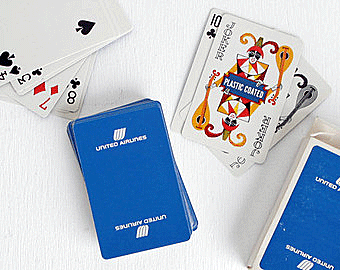 There are nearly 3,000 different card designs
known to have been issued by 438 airlines since the beginning of
commercial aviation. The oldest are the ones issued by Imperial Airways,
predecessor of British Airways, in the 1920s, featuring illustrations of
a biplane and destinations of Cairo, Baghdad, and Karachi. Another
interesting card from approximately the same era was the first card
issued by Transcontinental Air Transport (later TWA), showing a Ford
Tri-Motor parked in front of a passenger train, with the caption ‘Coast
to Coast by Plane and Train’. Back then, flying at night wasn’t
considered safe for passengers. There are nearly 3,000 different card designs
known to have been issued by 438 airlines since the beginning of
commercial aviation. The oldest are the ones issued by Imperial Airways,
predecessor of British Airways, in the 1920s, featuring illustrations of
a biplane and destinations of Cairo, Baghdad, and Karachi. Another
interesting card from approximately the same era was the first card
issued by Transcontinental Air Transport (later TWA), showing a Ford
Tri-Motor parked in front of a passenger train, with the caption ‘Coast
to Coast by Plane and Train’. Back then, flying at night wasn’t
considered safe for passengers.
As commercial air travel became more common,
airline playing card designs began to fall into five broad categories
featuring aircraft in the fleet or pictures of female flight attendants,
colorful pictures of destination cities or travel posters, joint
advertising with products or companies from other industries, designs
specifically for children, sometimes tied into a promotional theme such
as Disney characters, Snoopy, and Pokemon, designs which simply show a
carrier’s logo without any elaborate artwork
Airlines often employed playing cards to
commemorate an anniversary. Normally distributed for only a short period
of time, these are usually more difficult to come by than the ordinary
designs. Sometimes, airlines used odd shapes, such as round cards
packaged in leather cases.
Airline Wings
 In 1929, the General Manager of
Northwest Airways designed wings for his pilots. The Postmaster General
liked the design so much, he adopted the insignia as the official emblem
to be worn by airmail pilots. This first wing had a metal center with
the words "U.S. Air Mail" in raised letters, fitted into a
background of wings. Over the years, each airline designed their own
variation, including wings for navigators which were gold with a sextant
in the center. The airlines discontinued using navigators when Doppler
navigation came into widespread use in the early 1960's. When the
airlines began employing stewardesses, they designed a half wing
insignia for them. In 1929, the General Manager of
Northwest Airways designed wings for his pilots. The Postmaster General
liked the design so much, he adopted the insignia as the official emblem
to be worn by airmail pilots. This first wing had a metal center with
the words "U.S. Air Mail" in raised letters, fitted into a
background of wings. Over the years, each airline designed their own
variation, including wings for navigators which were gold with a sextant
in the center. The airlines discontinued using navigators when Doppler
navigation came into widespread use in the early 1960's. When the
airlines began employing stewardesses, they designed a half wing
insignia for them.
Since the first commercial airline flight,
airline companies have developed a variety of ways to expose their name
and image to the public. They learned early on to target children as
part of their advertising campaigns. As flying became more common place,
boys dreamed of becoming pilots and girls, stewardesses. Airlines
provided children with junior wings for each designation, junior
membership cards, log books, certificates, pilot and stewardess rings,
and special patches.
Manufactured and issued since the 1930's, today
there are over 900 known junior wings. Wings have been, and are still
made from cast metal, stamped tin, plastic, cloth, paper and vinyl,
attached using pin backs, "c" clasps, safety pins, push pins,
button backs, adhesive patches, and stickers.
Paper Goods
Airline-related paper goods are another
sub-category of this collectible. One of the most popular items is
timetables.
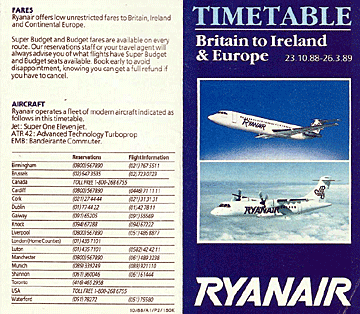 There are two main characteristics of airline
timetables that make them attractive to collectors–appearance,
including the cover design, photos, logos, and advertisements and the
content, including the flight information, fare data, and route map. As
soon as an airline replaces a timetable with a newer edition, that
timetable becomes a part of the historical record of airline history. There are two main characteristics of airline
timetables that make them attractive to collectors–appearance,
including the cover design, photos, logos, and advertisements and the
content, including the flight information, fare data, and route map. As
soon as an airline replaces a timetable with a newer edition, that
timetable becomes a part of the historical record of airline history.
Some collectors want a copy of every airline
timetable while others want a single issue to commemorate a special
occasion such as the first 747 flights for US carriers, airline mergers,
final issues for merged and bankrupted carriers, inaugurations of new
carriers, strikes, and color scheme changes.
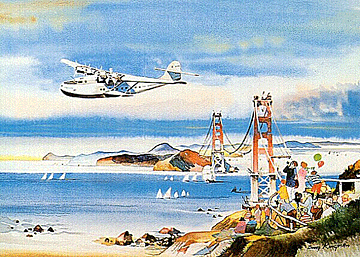 Airlines also issued postcards showing images
of the aircraft that they gave to passengers onboard as souvenirs.
Originally, these came as part of a flight travel packet and featured
photos of the airplane the passenger was flying on at the time. The
earliest example probably is from the St. Petersburg-Tampa Airboat
showing the Benoist Type XIV flying boat. Airlines also issued postcards showing images
of the aircraft that they gave to passengers onboard as souvenirs.
Originally, these came as part of a flight travel packet and featured
photos of the airplane the passenger was flying on at the time. The
earliest example probably is from the St. Petersburg-Tampa Airboat
showing the Benoist Type XIV flying boat.
Airlines placed travel packets in the seat
pockets of their planes. A typical package included a beautiful postcard
of the airplane, a small, pre-printed envelope/comment card, a
"seat occupied" card, a sheet of writing stationery and
matching envelope, a passenger information brochure, a fleet brochure
full of color photos and a route map, and a luggage label. The travel
packet’s exterior often had vignettes of various destinations.
Other paper items include posters advertising
travel aboard the airlines to exotic destinations and in the early days,
those advertising air shows, as well as onboard menus.
Advertising Items
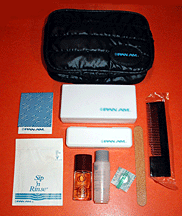 Finally, there’s a myriad of useful
specialty advertising items–travel kits, flight bags, blankets, etc.
Travel kits, given everyone in the early years before class seating on
flights and later only to those flying in First or Business Class,
included toothbrush and paste in a case, sleep mask, tissues,
moisturizing cream, a comb and a pen–each item bearing the airline’s
logo. And who doesn’t have a vinyl flight bag hidden away in a closet
or attic? These usually bore the airline’s on both sides, closed with
a zipper, and had an adjustable strap. Finally, there’s a myriad of useful
specialty advertising items–travel kits, flight bags, blankets, etc.
Travel kits, given everyone in the early years before class seating on
flights and later only to those flying in First or Business Class,
included toothbrush and paste in a case, sleep mask, tissues,
moisturizing cream, a comb and a pen–each item bearing the airline’s
logo. And who doesn’t have a vinyl flight bag hidden away in a closet
or attic? These usually bore the airline’s on both sides, closed with
a zipper, and had an adjustable strap.
One of the most unusual pieces of airline
memorabilia is a hatbox in which flight personnel could store and carry
their hats. A typical one from American Airlines featured a portrait of
a DC-3 in flight, both on the box lid and on the bottom. An American
Airlines flag decorated each end of the oval box, covered with images of
blue sky and clouds. A canvas strap with snap secures the lid, while a
shorter section serves as a handle for carrying.
What To Look For
According to Robert Marshall of
Transportation Hobby Collectibles (www.thconline.com),
collectors should look for well-preserved items, particularly in paper
items–ticket jackets, boarding passes, safety cards. He also
recommends items that show some style, a sense of class, or a great
vintage design, as well as those from defunct airlines like TWA, Braniff
and Pan Am, as these are highly collectible. Some, like Pan Am, flew
from the early days of commercial aviation in 1927 until its closing in
1991.
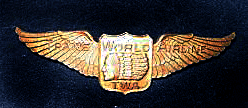 Dating airline collectibles can be difficult as
in the case of airline china and playing cards. Dating airline collectibles can be difficult as
in the case of airline china and playing cards.
It’s also hard to date postcards unless it
has been postal stamped or dated by the photographer for photo cards. Of
course, it’s possible to creatively date items by the logos or images
on them since these changed over time as the airline industry developed.
Playing card decks came sealed in cellophane.
Decks are worth more sealed, so collectors should keep the wrapper
intact. What shows through the wrapper is the actual card design most of
the time. However, collectors should watch for generic cards packaged
inside airline boxes or airline cards inside generic boxes.
While an "early" railroad item would
be from the 1880's, an early commercial aviation item would be from
around 1930. In those early days, each airline had only a handful of
planes and employees. A surprising number of items from those early days
do exist, although their rarity now commands substantial prices
Airline
Collectible Values
Generally any pre-World War II china
pieces are rare and highly sought after. Prices likewise reflect that
rarity and some pieces sell for nearly $1,000.
 Extremely rare playing cards, on the other
hand, sell for between $7 for an individual card to over $100 for a mint
deck. More recently, more common ones have appeared on eBay and are
hardly worth less than 50 cents for an individual card or under $5 per
deck. Unfortunately, over-zealous bidding has driven up prices beyond
expectations for some decks. Generally, the most available cards sell
for about $1 to $2 and decks for $10-25. Opened or used decks sell for
less. Extremely rare playing cards, on the other
hand, sell for between $7 for an individual card to over $100 for a mint
deck. More recently, more common ones have appeared on eBay and are
hardly worth less than 50 cents for an individual card or under $5 per
deck. Unfortunately, over-zealous bidding has driven up prices beyond
expectations for some decks. Generally, the most available cards sell
for about $1 to $2 and decks for $10-25. Opened or used decks sell for
less.
An Air France travel packet from 1956 can sell
for as much as $40, while a hatbox like the one mentioned above can sell
for as much as $180. A Continental lap blanket from 1968 now sells for
$60. And even Pan Am flight bags from 1978 sell for as much as $33.
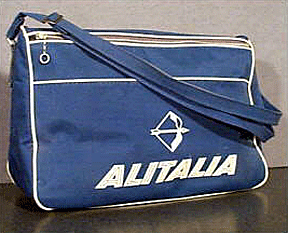 Airline flight bags are also in demand. They
were free to first-class customers until the 1970s. They now sell for
$10. Small plastic wing pins, which used to be given away to the
children now sell for $1 each. Metal wings sell for $25 a pair. Airline flight bags are also in demand. They
were free to first-class customers until the 1970s. They now sell for
$10. Small plastic wing pins, which used to be given away to the
children now sell for $1 each. Metal wings sell for $25 a pair.
The most expensive airline collectibles are
schedules and magazines. Aviation buffs like to collect them because
they gave information about earlier flights. But airline menus and
posters also sell well.
Marshall noted that since eBay, prices and
availability on some items have changed dramatically. "An American
Airlines ‘Welcome Aboard’ booklet from the 1940's with a cover image
of a stewardess in those military looking uniforms sold for upwards of
$45.00," he said. "Now, because of eBay, these books are
commonly traded back and forth and only seem to go for around $10, if
that."
Fortunately, those involved in the early years
of commercial aviation either as employees or passengers, didn’t
always discard older items and many ended up in closets and desk
drawers. While some value these items, others offer them at yard sales
or flea markets.
But for most airline collectible collectors,
airline memorabilia shows, like the annual Airliners International Show
plus many smaller one-day shows, are the best source of items. Airline
dinnerware is probably the most commonly found collectible at the shows.
Much of it comes from legitimate sources. When airlines changed their
logo or their china design, they’d sell off the older material or give
it to employees.
To
read more articles by Bob Brooke, please visit
his Web site.
<
Back to Collectibles Articles
Next Article > |
